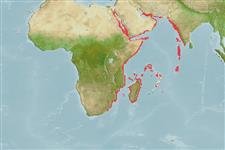Classification / Names
Common names from other countries
Main reference
Size / Weight / Age
Max length : 20.0 cm TL male/unsexed; (Ref. 5213)
Environment
Marine; reef-associated; depth range ? - 68 m (Ref. 26165)
Climate / Range
Tropical, preferred 28°C (Ref. 107945); 31°N - 32°S, 29°E - 77°E
Distribution
Short description
Dorsal
spines
(total): 12;
Dorsal
soft rays
(total): 13-14;
Anal
spines: 3;
Anal
soft rays: 7. Silvery, darker above, with 4 stripes along body and a dark brown opercular blotch (Ref. 2799). Upper opercle with a dark blotch and a stripe. Pored lateral line scales 49 - 53 and 5 - 6 on scaly sheath of caudal fin. Body depth in SL, 3.14 - 3.34; suborbital depth in eye diameter 1.0 or slightly over. Pectoral fin tip when vented, equal or reaching past the pelvic fin tip (Ref. 37522).
IUCN Red List Status (Ref. 115185)
Threat to humans
Harmless
Human uses
Fisheries: commercial; bait: occasionally
More information
ReferencesAquacultureAquaculture profileStrainsGeneticsAllele frequenciesHeritabilityDiseasesProcessingMass conversion
Tools
Special reports
Download XML
Internet sources
Estimates of some properties based on models
Phylogenetic diversity index
PD50 = 0.5000 many relatives (e.g. carps) 0.5 - 2.0 few relatives (e.g. lungfishes)
Trophic Level
4.0 ±0.67 se; Based on food items.
Resilience
High, minimum population doubling time less than 15 months (Preliminary K or Fecundity.)
Vulnerability
Low vulnerability (25 of 100)
Price category
